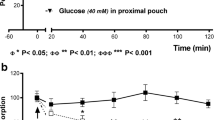Abstract
The mechanism by which histamine increases gastric mucosal blood flow (GMBF) was investigated in the anesthetized rat. The experiment was performed in the presence of tripelennamine, an H1 antagonist, to focus on the relationship between acid secretion (H2-receptor-mediated response) and GMBF. The stomach was mounted on a Lucite chamber, perfused with saline, and GMBF was measured by laser Doppler flowmetry simultaneously with acid secretion. Under these conditions, histamine at the submaximal dose significantly increased GMBF as well as acid secretion, and this increase of GMBF was completely blocked when acid secretion was inhibited by cimetidine or omeprazole. The elevation of GMBF caused by histamine was also significantly attenuated when luminal H+ was removed by intraluminal perfusion with NaHCO3 or glycine. Glycine by itself did not affect the increase of acid secretion induced by histamine and the increase of GMBF caused by isoproterenol, yet significantly inhibited the GMBF response induced by pentagastrin. Intraluminal perfusion with HCl also produced an increase of GMBF in a concentration-related manner, even in the presence of omeprazole during histamine infusion. Pretreatment of the animals with indomethacin significantly blocked the GMBF responses induced by either histamine or luminal HCl. These results suggest that the increase of GMBF during acid secretion induced by histamine may be caused by luminal H+ and involve endogenous prostaglandins in its mechanism.
Similar content being viewed by others
References
Jacobson ED, Linford RH, Grossman MI: Gastric secretion in related to mucosal blood flow studies by a clearance technic. J Clin Invest 45:1–13, 1966
Moody F: Gastric blood flow and acid secretion during direct intraarterial histamine administration. Gastroenterology 52:211–214, 1967
Leung FW, Guth PH, Scremin OU, Golanska EM, Kauffman GL Jr. Regional gastric mucosal blood flow measurements by hydrogen gas clearance in the anesthetized rat and rabbit. Gastroenterology 87:28–36, 1987
Main IHM, Whittle BJR: A Study of vascular and acid secretory responses of the rat gastric mucosa to histamine. J Physiol (London). 257:407–418, 1976
Guth PH, Smith E: Histamine receptors in the gastric microcirculation. Gut 19:1059–1063, 1978
Guth PH, Moler TL, Smith E: H1 and H2 histamine receptors in rat gastric submucosal arterioles. Microvasc Res 19:320–328, 1977
Gerkens JF, Flexner C, Oates JA, Shand DG: Prostaglandin and histamine involvement in the gastric vasodilator action of pentagastrin. J Pharmacol Exp Ther 201:421–426, 1977
Gerkens JF, Shand DG, Flexner C, Nies AS, Oates JA, Data JL: Effect of indomethacin and aspirin on gastric blood flow and acid secretion. J Pharmacol Exp Ther 203:646–652, 1977
Gerber JG, Nies AS: The role of prostaglandins in histamine-induced gastric vasodilation in the dog. J Pharmacol Exp Ther 213:79–84, 1980
Pique JM, Leung FW, Tan HW, Livingston E, Scremin OU, Guth PH: Gastric mucosal blood flow response to stimulation and inhibition of gastric acid secretion. Gastroenterology 95:642–650, 1988
Kato S, Takeuchi K, Okabe S: Characterization of gastric mucosal blood flow in response to histamine in the rat. Gastroenterology 100:A96, 1991
Larsson H, Mattson H, Sundell G, Carlsson E: Animal pharmacodynamics of omeprazole: A survey of its pharmacological propertiesin vivo. Scand J Gastroenterol 20(suppl 108):23–35, 1985
Takeuchi K, Ishihara Y, Okada M, Niida H, Okabe S: A continuous monitoring of mucosal integrity and secretory activity in the rat stomach. Jpn J Pharmacol 49:235–244, 1988
Matsumoto J, Ueshima K, Takeuchi K, Okabe S: Capsaicin-sensitive afferent neurons in adaptive responses of the rat stomach induced by a mild irritant. Jpn J Pharmacol 55:181–185, 1991
Sandvik AK, Waldum HL, Kleveland PM, Schulze SB: Gastrin produces an immediate and dose-dependent histamine release preceding acid secretion in the totally isolated, vascularly perfused rat stomach. Scand J Gastroenterol 22:803–808, 1987
Whittle BJR: Mechanisms underlying gastric mucosal damage induced by indomethacin and bile-salts, and the action of prostaglandins. Br J Pharmacol 60:455–460, 1977
Bruggeman TM, Wood JG, Davenport HW: Local control of blood flow in the dog's stomach; vasodilatation caused by acid back-diffusion following topical application of salicylic acid. Gastroenterology 77:736–744, 1979
Starlinger M, Schiessel R, Hung CR, Silen W: H+ back-diffusion stimulating gastric mucosal blood flow in the rabbit fundus. Surgery 89:232–234, 1981
Svanes K, Varhang JE, Holm P, Bakke A, Romslo I: Effects of haemorrhagic shock on gastric blood flow and acid secretion in cats. Acta Chir Scand 147:81–88, 1981
Perry MA, Haedicke GJ, Bulkley GB, Kvietys PR, Granger N: Relationship between acid secretion and blood flow in the canine stomach; role of oxygen consumption. Gastroenterology 85:529–534, 1983
Gerber JG, Guth PH: Role of adenosine in the gastric mucosal blood flow response to pentagastrin in the rat. J Pharmacol Exp Ther 251:550–556, 1989
Guth PH: Pentagastrin and histamine in the regulation of gastric mucosal blood flow. Scand J Gastroenterol 26(suppl 180):118–125, 1991
Walder CE, Thiemermann C, Vane JR: Endothelium derived relaxing factor participates in the increased blood flow in response to pentagastrin in the rat stomach mucosa. Proc R Soc London B241:195–200, 1990
Pique JM, Esplugues JV, Whittle BJR: Nitric oxide is a prime mediator of pentagastrin-stimulated rat gastric mucosal blood flow during acid secretion. Gastroenterology 100:A142, 1991
Holzer P, Livingston EH, Guth PH: Sensory neurons signal for an increase in rat gastric mucosal blood flow in the face of pending acid injury. Gastroenterology 101:416–424, 1991
Author information
Authors and Affiliations
Rights and permissions
About this article
Cite this article
Kato, S., Takeuchi, K. & Okabe, S. Mechanism by which histamine increases gastric mucosal blood flow in the rat. Digest Dis Sci 38, 1224–1232 (1993). https://doi.org/10.1007/BF01296071
Received:
Revised:
Accepted:
Issue Date:
DOI: https://doi.org/10.1007/BF01296071




